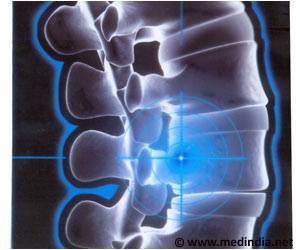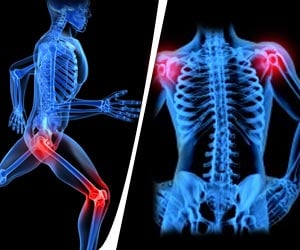Musculoskeletal disorders -conditions and injuries affecting the bones, joints and muscles- can be painful and debilitating, affecting daily quality of life.

‘The most prevalent musculoskeletal disorders are arthritis and related conditions; back and neck pain; injuries from falls, work, military service and sports, and osteoporosis.’





"This report provides the critical data needed to understand the magnitude of the problem, and the burden, of musculoskeletal disease in our country," said David Pisetsky, MD, USBJI president, and professor of medicine and immunology at Duke University Medical School. "The number of visits to physicians for these disorders, the cost of treating them, and the indirect costs associated with pain and loss of mobility, are proportionately much higher than the resources currently being allocated to combat these conditions and injuries." "As a nation, we need to establish greater funding for musculoskeletal research, improve our understanding and strategies for prevention and treatment of these injuries and conditions, and ensure that more adults and children receive appropriate treatment sooner, and on an ongoing basis, to ensure quality of life and productivity," said Stuart L. Weinstein, MD, co-chair of the report's Steering Committee and a professor of orthopaedics and rehabilitation at the University of Iowa Hospitals and Clinics.
Prevalence and predictions
According to the report, the most prevalent musculoskeletal disorders are arthritis and related conditions; back and neck pain; injuries from falls, work, military service and sports; and osteoporosis, a loss of bone density increasing fracture risk, primarily in older women. An estimated 126.6 million Americans were living with a musculoskeletal disorder in 2012.
More specifically, arthritis is the most common cause of disability, with 51.8 million--half of U.S. adults age 65 and older--suffering from the disease. With the aging of the American population, the report projects arthritis prevalence to increase to 67 million people, or 25 percent of the adult population, by 2030. Arthritis is not just a disease for older Americans, with two-thirds of arthritis sufferers under age 65. Back and neck pain affects nearly one in three, or 75.7 million adults.
Advertisement
Cost and health care impact
Advertisement
Other data on the costs of musculoskeletal diseases and injuries include eighteen percent of all health care visits in 2010 were related to musculoskeletal conditions, including 52 million visits for low back pain, and 66 million for bone and joint injuries, including 14 million visits for childhood injuries. Arthritis and rheumatoid conditions resulted in an estimated 6.7 million annual hospitalizations.
The average annual cost per person for treatment of a musculoskeletal condition is $7,800. The estimated annual cost for medical care to treat all forms of arthritis and joint pain was $580.9 billion, which represented a 131 percent increase (in 2011 dollars) over 2000. In 2012, 25.5 million people lost an average of 11.4 days of work due to back or neck pain, for a total of 290.8 million lost workdays in 2012 alone. Among children and adolescents, musculoskeletal conditions are surpassed only by respiratory infections as a cause of missed school days.
Opportunities for action
The report provides recommendations to curb the tremendous economic and societal costs of musculoskeletal disorders, including accelerating research that compares treatment alternatives, develops new treatments and evaluates possible preventative approaches. Improving understanding of the role of behavior change in prevention and treatment, including weight loss and self-management of conditions once they arise. Ensuring that a higher percentage of the affected population receives access to evidence-based treatments. Implementing proven prevention strategies for sports injuries, workplace injuries, and injuries in the military. Ensuring that all children with chronic medical and musculoskeletal problems have access to care. Promoting better coordination between physicians and other health care providers treating musculoskeletal disorders: primary care physicians, specialists, physical therapists, chiropractors. Ensuring that health care providers, especially primary care physicians, have the appropriate training to diagnose, and if necessary, refer patients for appropriate treatment.
Addressing data limitations, and improve systems, to improve our understanding of these conditions and how best to screen, diagnose and treat them. This includes the impact of sex and gender on musculoskeletal disorders and responses to treatment, and tracking pediatric patients through adulthood to determine the lifelong burden of musculoskeletal disease.
"If we continue on our current trajectory, we are choosing to accept more prevalence and incidence of these disorders, spiraling costs, restricted access to needed services, and less success in alleviating pain and suffering - a high cost," said Edward H. Yelin, PhD, co-chair of the report's steering committee, and professor of medicine and health policy at the University of California, San Francisco. "The time to act to change this scenario to one with more evidence-based interventions and effective treatments, while simultaneously focusing on prevention, doing better by our society and economy, is now."
Source-Eurekalert










